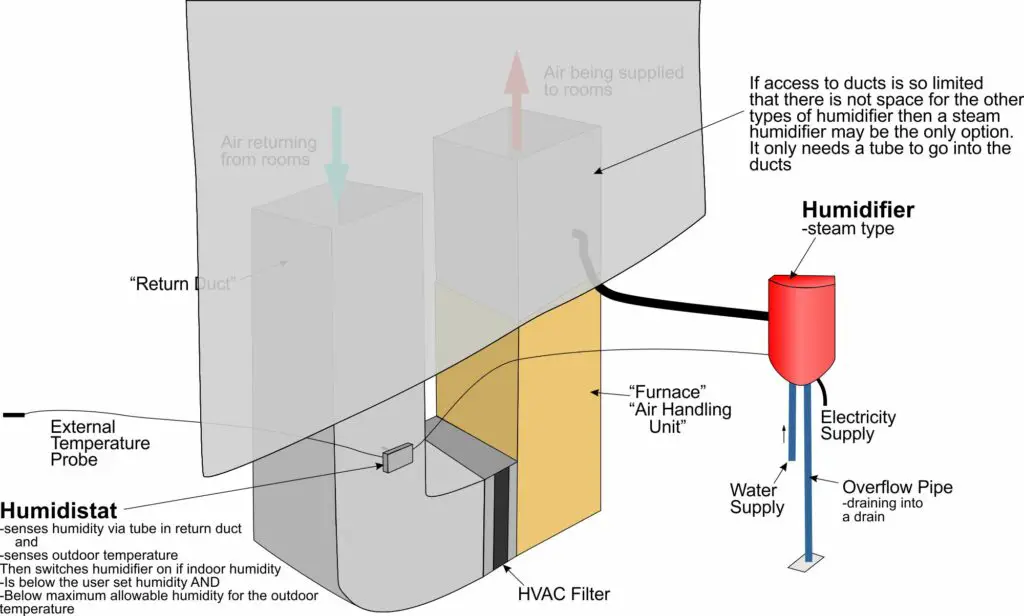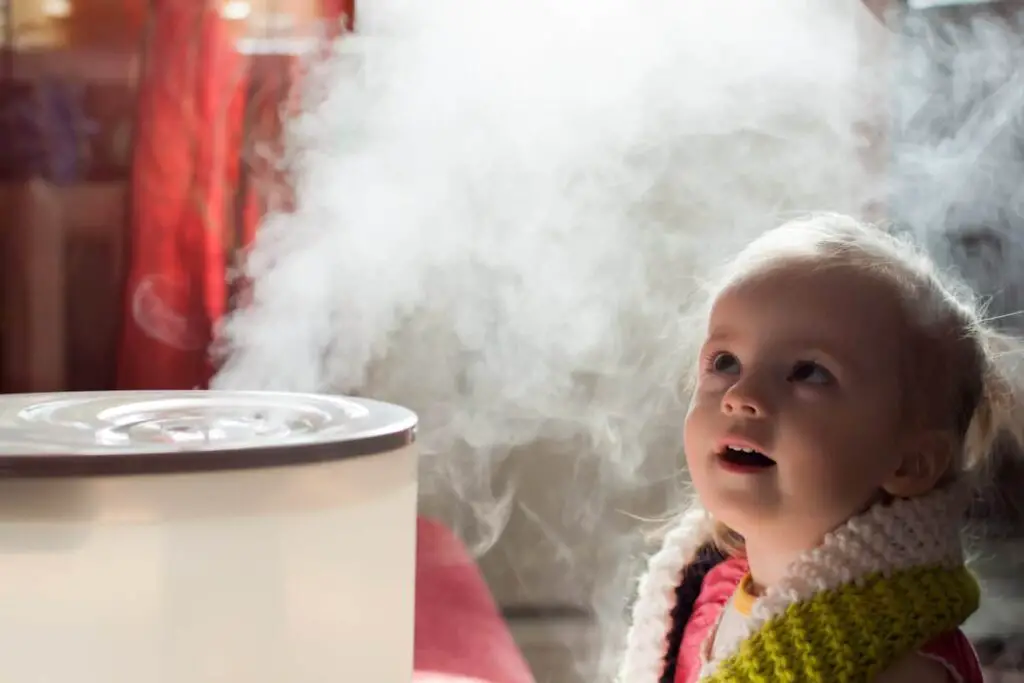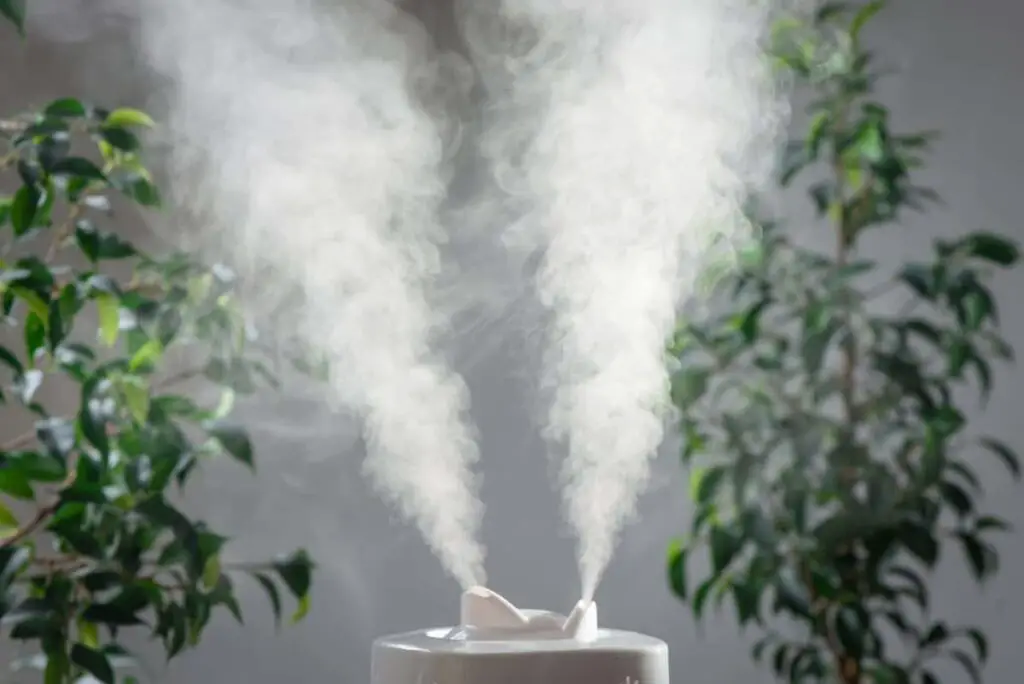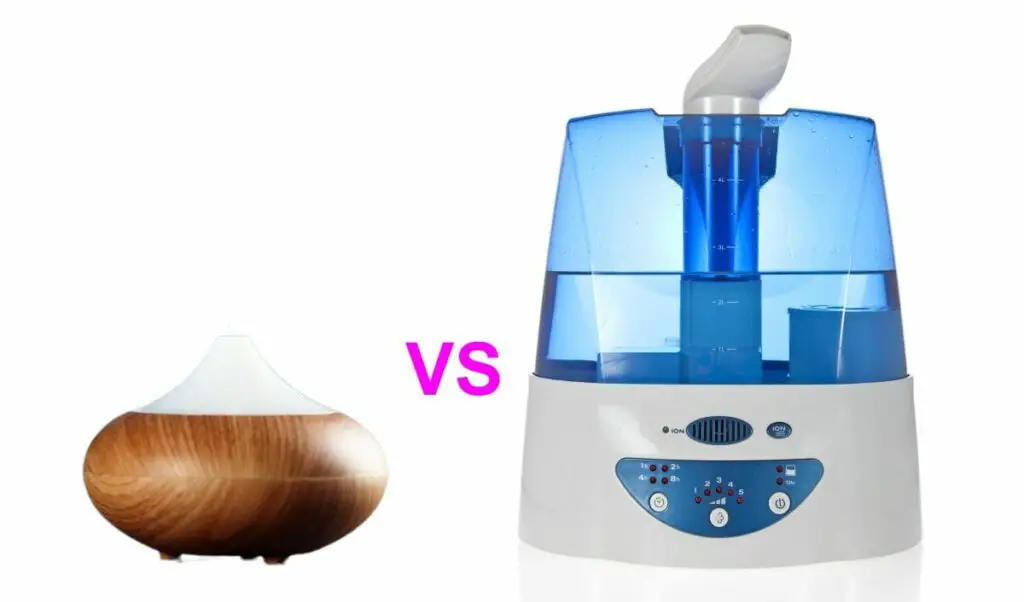Like me, you may find dry air uncomfortable. When the humidity in your air gets down to 25% or less, skin can feel dry, as can the mucous membranes in our noses and mouths. Also, nose bleeds and chapped lips are more common. Some people may develop increased respiratory symptoms. So humidity is an important part of indoor air quality.
A low humidity level can also be a problem for some objects. For instance, wooden furniture or flooring may dry out to the extent that it cracks.
As a general rule, almost all HVAC systems can have a humidifier unit installed to create a whole house humidifier. The installation is not difficult or very expensive. There are 3 main types of HVAC humidifier, if your home is less than 4000 square feet, a fan powered humidifier is best otherwise, you need a steam humidifier.
A whole house humidifier has at least 6 advantages-
- More even humidification throughout the home
- The outside temperature is taken into account. This affects the water carrying capacity of the air. This data is used by the central humidistat to avoid supersaturating the air and so causing condensation. Portable humidifiers and you will not be using outside temperature to decide if you should turn off humidification. (Explained below).
- You will not have lots of extra electrical appliances littering your house
- Much more maintenance free than lots of portable humidifiers which need cleaning once or twice a week and filling with water. An HVAC humidifier system needs one filter pad change per year.
- Safer for children than an ultrasonic, air washer/impeller humidifier or steam humidifier
- Quieter for adults than a portable evaporative humidifier, the most suitable one for children
You should of course first check with a humidity meter (hygrometer). You may already have one, in your humidistat either on your air conditioning unit’s digital control or on the HVAC system itself. Failing this, you should buy one – they start at about $12. The most likely time of year to find a low humidity is during times when the air temperature is low.
Installation is not difficult or very expensive. Here is a YouTube video of the installation of a fan powered humidifier-
There Are Health Benefits From Using a Humidifier if the Humidity is Low
If the humidity in your home is very low, a humidifier can help your health in several ways-
1) A humidifier is Likely to Lower the Severity of Viral Respiratory Infections
If the humidity of the air is too low, humidifying the air can protect us against respiratory infections. One of our defence mechanisms, mucociliary clearance of our airways, relies on mucus in our airways trapping particles, bacteria and viruses. The mucocilliary elevator then moves the trapped virus or bacteria up and out of our lungs. If the air is too dry, the mucus becomes stickier and more difficult to move.
So at very low humidities when this mechanism is impaired, and viral respiratory infections such as influenza can be more severe. In one study mice at low relative humidity (10-20%), developed much more severe influenza. This found that other defence mechanisms in the lungs were also impaired-
- Mucocilliary clearance, so the virus was not cleared from the airways as well
- Innate antiviral defence
- Tissue repair function
2) A Humidifier May Relieve a Dry Cough
If the air is too dry, the mucus becomes stickier and more difficult to move. This can also lead to collection of mucus in parts of our airways, causing irritation and coughing. This would only apply if the dry cough is caused by low humidity. There are of course plenty of other causes for dry coughs. If you have a cough that is persistent for longer than 2 weeks, you should always see your physician.
3) A Humidifier May Prevent Mucous Membranes in Your Nose and Throat From Drying Out
If the air is too dry, it can cause our mucous membranes to dry out. Mucous membranes are surfaces in our bodies such as our mouths, nasal passages and throat which can become sore and uncomfortable if they dry out. Nose bleeds may be related to low humidity. Also, our lips can become chapped, which can be made better by raising the humidity.
4) A Humidifier Can Prevent Very Dry Skin
Some people notice dry skin in conditions of low humidity, and people with eczema or other skin conditions may find that their skin is worse under conditions of low humidity.
Another benefit of a humidifier is that it may protect wooden objects or flooring in our houses. This is because anything made of wood in our houses will shrink and warp as it dries out. This can lead to cracks around door frames and of course problems with wooden flooring.
Low Humidity is Usually a Problem in Winter in Most Areas
Low humidity is a problem when the outdoor air is cold. So it is usually a winter problem. This graph shows the water carrying capacity of air at different outdoor temperatures-

This lower water carrying capacity of the air at colder temperatures limits the relative humidity that you should aim for at lower outdoor temperatures. Otherwise if you have a relative humidity in your ductwork, that is higher than the water carrying capacity of the air, then water will condense out forming a dew. This water in the ductwork this can lead to the growth of fungi.
Here is a table of outdoor temperature and recommended relative humidity (RH) indoors-
| Outside Temperature (oF) | Recommended Relative Humidity |
|---|---|
| +40 | 45% |
| +30 | 40% |
| +20 | 35% |
| +10 | 30% |
| 0 | 25% |
| -10 | 20% |
| -20 | 15% |
(from AprilAire 800 manual)
Fortunately, the humidistats are smart and will use this sort of data to automatically adjust the humidifier.
Sealing Your Home is the First Step in Combating Low Humidity
Just in day-to-day living, we are introducing water vapor into our homes all the time. The air that we breathe out has water vapor in it. There is also some loss of water vapor from our skin. When we cook by boiling or steam food, that obviously introduces more water vapor into the environment and increases the humidity level. In addition, having showers will also release water vapor into the air in the house.
So as we are constantly releasing water vapor into the air in our homes, how does the humidity level become so low? The answer is that cold dry air manages to seep into our homes through gaps in the building’s envelope. These gaps are often around water pipes, gas pipes and electric wires that enter the house from, for instance, a crawlspace. Also ill-fitting doors and windows with drafts will let in cold dry air. In many loft spaces there will be a connection between at least part of the space immediately under the roof and the outside.
In a similar way, through the same cracks and holes, the more humid air within the home can escape through these gaps.
So one of the first things to do is to seal off as many gaps connecting the inside of your home with the air outside as possible. Once you have done this, check the humidity. If it is above 30% then a humidifier is not essential. However, you may still want one for comfort.
Potential Problems With a Whole House Humidifier
Cost
Installation cost for a whole house humidifier averages about $500. Labour and parts are $100-$300 but can be $500 for a steam humidifier. The humidifier system hardware is generally $100-$300 except for steam humidifiers, which range from $300-$1500.
There are some running costs for the bypass and power humidifiers in terms of pads. The evaporator pads are usually replaced once a year and cost $8-$20.
The steam humidifier is the most powerful, but also the one that consumes the most electricity. The fan powered humidifier consumes much less electricity because rather than heat water, it is simply turning a fan. This is much more energy-efficient. The bypass humidifier does not consume any electricity itself but needs your air blower to be on which consumes more than a fan powered humidifier.
However, providing your ducting is not in very cold spaces in your home, the steam humidifier and the fan powered humidifier can be run independently of the heating system. So that you would have humidification without using electricity to run the HVAC system – actually saving electricity.
Fungal Growth in HVAC Ducts
Introducing humidity into the HVAC ducting can cause a problem if the HVAC duct is cold enough for the water vapor from the humidifier to condense on the walls of the duct. This will then potentially allow fungi to grow in the duct. This is more likely to occur if the ducting is not insulated and if the ducting is in a cold area such as an attic.
Growth of mold in the HVAC system would be very detrimental to your air quality and may go undetected for some time. For asthmatics, it could even be dangerous.
So it is a good idea to only run the humidifier when the heating is on and the ducts are warm. This should stop any condensation in the ducts and hence growth of mold in them.
Is Water Consumption of an HVAC Humidifier a Problem?
Not really. Flow through pads in bypass or power humidifiers waste about 65% of water that is supplied to them. This will mean 10 gallons per day of water is wasted-not enough to make much difference to your water bill. On the other hand, steam humidifiers are the most water efficient, converting virtually all the water into water vapour.
Does a Whole Home Humidifier Need Distilled Water?
Unlike portable humidifiers, many of which need distilled water a whole home humidifier does not. This is because it uses evaporation and also does not have a reservoir of water sitting around which bacteria or fungi can grow in. They are plumbed into the home’s water system. Please see this article.
Consider a Duel Fuel System For Your HVAC System
If you have a gas furnace inside the air-conditioned space of your home, it may be lowering the humidity in your home. This happens when the gas furnace takes air from within your home to burn the gas. The exhaust fumes then exit your home. So the relatively more humid air from your home is being taken through a burning process and then exits your home in the exhaust fumes. This air is then replaced by less humid outside air seeping into your home.
A potential solution to this is to have a dual fuel system to minimize the time that you are burning gas. Heat pumps are commonly used, although expensive to install. They produce mildly to moderately warm air and so are not a complete replacement for a gas furnace but can cope with mildly cold weather. Because they do not emit exhaust gas they are not constantly removing humid air from your home.
Although sometimes referred to as a “furnace humidifier” in general whole house humidifiers humidify air from the duct leaving the furnace, the supply duct. There are 3 main types-
A Bypass Humidifier Integrated With Your HVAC System is the Cheapest Whole House Humidifier
In this the air enters the humidifier from the supply duct and then passes into the return duct-

These rely on the fan working and the pressure in the supply duct being higher than that in the return duct because of the fan. So air flows from the higher pressure in the supply duct through a humidifier to the lower pressure in the return duct.
In the humidifier there is water soaked material. This can be mounted on a drum-a “drum humidifier”. An alternative is a fixed evaporative pad filter soaked in water-“a flow through humidifier”.
Water evaporates from all of these arrangements, and so both types of humidifier are examples of evaporative humidifiers. From here the air goes back through a bypass into the return duct (please see diagram). So the air in the return duct is warmer than it would normally be, and there is a theoretical risk of your system overheating. With the proper installation of the bypass system, this should not be a problem.
The drum humidifier has a rotating drum with absorbant material mounted on it constantly travelling through a bath of water. The bath of water has a floating valve which controls the water supply. As the water level goes down the float goes down and opens the valve which lets water flow into the reservoir to top it up again. This type of humidifier does need an overflow pipe going to a drain. It does not use much water as the float valve just adds enough water to top up the reservoir. The problem with this type of humidifier is that there is a stagnant reservoir of water in which bacteria and fungi can grow. Also, parts for these drum humidifiers are becoming more expensive as they have been superseded by flow through humidifiers.
A flow through humidifier has a pad which is designed to let a large airflow through but also slow down the water dripping down it. It is made of aluminium foil mesh dipped in liquid clay. The large surface area of the clay is ideal for evaporation. The water is slowed down by having small reservoirs spaced out over the whole pad at different levels. It can be impregnated with antibacterial chemicals. The main disadvantage of this system is that it wastes water. This is because water constantly drips through the pad and goes down the drain. However, the water wastage is unlikely to exceed 10 gallons per day and so will not significantly increase your water bill.
This bypass system is the cheapest, but it will struggle to humidify a home that is greater than 2500 sq ft.
Fan powered humidifiers “power humidifiers” have their own fan and add humidified air directly into the duct.
In this type of humidifier the air enters the humidifier from the supply duct is passed over a water panel and then back into the supply duct.
These include a fan that blows air across the water panel so causing greater evaporation of water. The water panel is the replaceable unit with a small reservoir at the top. Holes in the bottom of this reservoir allow water to drip into the panel. The panel is formed of a lattice work which is designed to slow the passage of water down it, holding it up in little collections. This then gives more time for evaporation by the air being driven through the panel by the fan.
These pads eventually develop mineral deposits and cannot be cleaned, so they need changing every 6-12 months.
Because of the integral fan in a power humidifier, it can be run independently of the HVAC system. Although, as explained above, this could lead to condensation in the ductwork. It is better to only run a humidifier when the heating system is on to decrease the risk of condensation in the ducts. Also because of the integral fan, they do not need a bypass duct and can be installed in small spaces.

| Bypass System | Fan Powered |
|---|---|
| No power needed -less expensive to run -less sophisticated control user needs to manually open bypass manually in winter and close in summer | Power needed -more expensive to run -more sophisticated smart home control possible |
| Harder more expensive installation* | Easy low cost installation* |
| Lower cost for hardware* | Higher cost for hardware eg $250-300 * |
| Good performance-will humidify a good area of home eg 2500sq ft | Better performance maximum-will humidify 4000-4500 sq ft |
| Can only add humidity when the fan of the air conditioning system is on | Can add humidity independent of AC system being on |
| May make a whistling sound-not loud | |
| Evaporator pad change once per year | Evaporator pad change after 6 months use-so as many homes will not need humidifier in the summer really means once per year |
*The higher cost of installation of the bypass humidifier tends to offset the higher cost of equipment for the fan powered humidifier. So the combined hardware and installation costs are fairly similar for both systems.
A Steam Humidifier Attached to Your HVAC System is the Most Powerful Whole Home Humidifier
These boil water and release steam into the ducting system. They generate a large amount of humidity relatively quickly and so need to run for a shorter length of time than other humidifiers. They are also able to humidify larger homes – up to 6000 sq ft.

They can run independently of the HVAC system, although as outlined above this can lead to condensation in the ducts and growth of fungi, “mold”.
If the space around the supply and return ducts is very limited, a steam humidifier may be the only option. A steam humidifier only needs enough space to fit a pipe into the duct, not a whole unit onto the surface of the duct.
This is the most water efficient humidifier, virtually all the water that flows into the humidifier is converted to steam.
If I Have 2 HVAC Systems, One Upstairs and One Downstairs Do I Need 2 Humidifiers?
The short answer is, no. If a humidifier is put onto the downstairs HVAC system, the humid air will rise up the house.
Conclusion
So a whole home humidifier is better than several portable units, if you have a home less than 4000 square ft a fan powered humidifier is probably your best option. Above this size of home, you really need to steam humidifier. Also, if there may not be sufficient room around the HVAC ducts to fit a unit. In this case, the steam humidifier is the only practical solution.
If your HVAC ducts are in space is your house that is cold, then to stop condensation it is best to only run the humidifier when the heating system is on. Otherwise water will condense on the HVAC ducts and provide an environment in which fungi grow in the ducts. If fungi grow in the ducts, this will then mean that your HVAC system could blow out pieces of fungus and fungal spores all over your house.
Related Questions
Related Articles
Different Types of Humidifiers-Only 1 Type Will be Perfect For You

The Difference Between an Air Purifier and a Humidifier-13 Important Health Effects

Do Humidifiers Help With Asthma?



